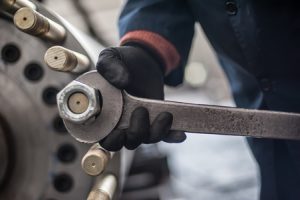[breadcrumb]
How Can an Engineman Get Mesothelioma by Occupational Exposure to Asbestos?
Enginemen are members of the U.S. Navy or Coast Guard who operate, service and repair internal combustion engines that power ships and smaller vessels. Most of the time, these workers work with diesel engines. They oversee the operation of diesel engines and maintain the engines and corresponding ship parts like gears, air compressors and propellers.
Asbestos was often contained on ships because it helped keep them watertight and also served as an excellent insulating material. Engineman can be exposed to asbestos when wire-brushing or scraping asbestos materials that are contained within engine components. Additionally, they may have inserted new gaskets and packing to create custom fits. These materials may have been made of asbestos. Enginemen often work in engine rooms that are small and poorly ventilated, so once these materials were disturbed, they may remain in the environment for some time to come.
Locations in the United States for the Highest Employment Rates for Enginemen
There are currently 5,500 men and women who are classified in this position in the United States. Most enginemen work in coastal states aboard ships or tending to ships on shores.
Similar Occupations as Enginemen
Similar occupations as enginemen include:
- Aircraft and avionics equipment mechanics technicians
- Automotive body and glass repairers
- Automotive service technicians and mechanics
- Diesel engine specialists
- Engine fitters
- Heavy vehicle and mobile equipment service technicians
- Locomotive engineers
- Small engine mechanics
Lawsuits and Settlements Involving Enginemen and Mesothelioma
There have been a few notable cases involving enginemen and multimillion-dollar verdicts against defendants held responsible for their exposure to asbestos. For example, a Philadelphia court awarded more than $4.5 million in 2009 to a former U.S. Navy engineman and his wife after finding that the man’s malignant pleural mesothelioma was caused by asbestos exposure that occurred from 1948 to 1957 when the man worked on diesel engines, valves and pumps that required replacing asbestos-containing gasket and packing materials.
In a 2001 case, four workers joined together in a case that named more than 20 manufacturers of asbestos products after they developed mesothelioma. One of the four individuals was a former engineman for the U.S. Coast Guard. The case yielded a verdict of $64.65 million. Most of the defendants settled before trial for undisclosed amounts. At the time of trial, the remaining defendants were Westinghouse Electric Corp, Worthington Corp. and Owens-Corning Fiberglass Corp.
Studies Related to Enginemen and Asbestos
There have been a few studies that have explored the connection between people who worked with and around engines and asbestos exposure. In the 2007 study entitled “Lung cancer and mesothelioma among engine room crew–case reports with risk assessment of previous and ongoing exposure to carcinogens,” researchers used case reports to identify the hazards of previous and ongoing carcinogenic exposure in the engine rooms of ships. Researchers concluded that asbestos exposure was a causal factor in the mesothelioma cases and a clear risk factor in the lung cancer cases.
Another study entitled “Asbestos-related cancers among 28,300 military servicemen in the Royal Norwegian Navy” and published in 2009 focused on officers and enlisted servicemen who developed asbestos-related cancers. Increased risk of mesothelioma and lung cancer was observed among engine room crews.
In “Cancer at sea: a case-control study among male Finnish seafarers,” researchers studied the possible occupational exposures for the increased incidence of many types of cancers among seafarers. They found that engine crew workers who had been employed in this industry for more than 20 years were nearly 10 times more likely to develop mesothelioma in comparison to the general population.
Types of Asbestos Products Used by Enginemen
Enginemen may be exposed to a variety of materials that contain asbestos, including gaskets, valves, sealants, packing materials and metal sheets. Additionally, insulation materials may have been made with asbestos.
Manufacturers of Asbestos Products Used by Enginemen
Some manufactures that produced asbestos products that enginemen may have been exposed to include:
- Alfa Laval, Inc.
- Allied Signal, Inc.
- American Biltrite, Inc.
- American Cyanamid Company
- American Olean Tile Co.
- American Standard, Inc.
- Armstrong International, Inc.
- Atlantic Richfield Company
- Aurora Pump Company
- Bath Iron Works
- Bechtel Corporation
- Bell & Gossett Company
- Bergen Tile & Linoleum Co.
- Bestobell Steam Traps
- Bird Corporation
- Boise Cascade Corporation
- Buffalo Pumps, Inc.
- Burnham Corporation
- CertainTeed Corporation
- Cleaver Brooks Company
- Crown, Cork & Seal Company
- DAP, Inc.
- Delaval Steam Turbine
- Duro Dyne Corporation
- Electric Boat Corporation
- Ericcson, Inc.
- Fisher Scientific Company
- FMC Corporation
- Foseco, Inc.
- Foster Wheeler Corporation
- Gardner Denver, Inc.
- Georgia Pacific Corporation
- Gould’s Pumps, Incorporation
- Hollingsworth & Vose Company
- Ingersoll-Rand Company
- H. France Refractories Co., Inc.
- John Crane Company
- Metalclad Insulation
- Milwaukee Valve Company
- Owens-Illinois, Inc.
- Riley Stoker Corporation
- Sid Harvey Industries, Inc.
- Spriax Sarco, Inc.
- Syd Carpenter
- Uniroyal Holding, Inc.
- Viking Pump, Inc.
- Warren Pumps, Inc.
- Weil-McLain Co.
- 3M

